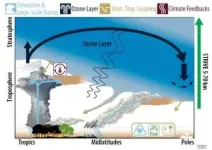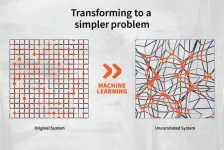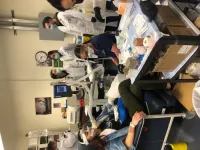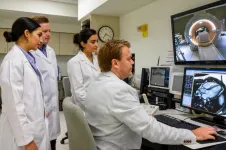STRIVE seeks to better understand the troposphere that we inhabit and the stratosphere above it, where the ozone layer is, as well as the interface where these two layers meet. That interface, about 6 miles (10 kilometers) above the surface, is where important atmospheric chemistry, circulation and climate processes occur.
In addition to STRIVE, two other teams among the finalists also include researchers from the UW.
The four teams that reached the proof-of-concept stage will spend the next year refining their proposals. NASA will then review the concept study reports and select two for implementation. Projects that reach the final stage will have a budget of up to $310 million to build the instruments, which NASA will launch into orbit in 2030 or 2032. The satellites are expected to have an initial working life of two to three years.
Lyatt Jaeglé, professor of atmospheric sciences at the UW, is principal investigator of STRIVE, or “Stratosphere Troposphere Response using Infrared Vertically-Resolved Light Explorer.” The national-scale team includes partners from academia, industry and federal science labs.
The two instruments aboard the STRIVE spacecraft would observe temperature, ozone, water vapor, methane, reactive gases, smoke and other aerosol particles. They will collect 400,000 sets of observations every day — hundreds to thousands of times more than what’s possible now. Instead of looking straight down at the Earth, the STRIVE instruments point at an angle to Earth’s surface, allowing them to capture the atmospheric layers in greater detail.
These observations could help to monitor how the UV-absorbing ozone layer is rebuilding or deteriorating in the atmosphere; how smoke particles from volcanoes, wildfires or human emissions travel through the atmosphere and influence air quality; and how water vapor, ozone, and high-elevation clouds influence the climate system.
The STRIVE system would also support longer-range weather forecasts.
“Before a major weather event at the surface, there can be precursor signs that happen in the stratosphere,” Jaeglé said. “And we see those weeks ahead of time. Observing the stratosphere and how these signals propagate down will be key to getting better weather forecasts on subseasonal to seasonal scales, so two weeks to two months in advance.”
As several NASA satellites near the end of their working lifetimes, the agency is looking for future possibilities to continue their legacy of tracking Earth’s changes.
“For observing the Earth, before we've had these multibillion-dollar instruments and platforms that take much longer to design and to put in operation. I think the overall idea is to move to a nimbler, faster set of satellite missions that will be designed more quickly and cost less,” Jaeglé said. “NASA will still pursue the bigger missions, but these smaller missions are another tool that they’re moving forward with.”
Jun Wang at the University of Iowa is the deputy principal investigator of STRIVE, and Luke Oman at NASA’s Goddard Space Flight Center is the project scientist. Several NASA Goddard scientists are also involved. Other UW members of STRIVE are professor Qiang Fu, assistant professor Alex Turner and affiliate faculty member Daehyun Kim, all in the UW Department of Atmospheric Sciences.
Other institutions include the Pacific Northwest National Laboratory, the Lawrence Livermore National Laboratory, the National Center for Atmospheric Research, NorthWest Research Associates, Science Systems and Applications, NASA’s Goddard Institute for Space Studies, the University of Colorado-Boulder, the University of Toronto and Morgan State University.
The STRIVE team will spend the next year developing a report with an in-depth engineering, cost and technical analysis.
“It’s extremely exciting. This was a team effort, with many people involved,” Jaeglé said. “Also a bit daunting because the next year will be a very busy one, but very exciting for how to make these concepts become a reality.”
Two other projects among the four finalists also involve UW scientists
The EDGE proposal, led by the University of California, San Diego, proposes a new laser instrument to measure the height of vegetation, glaciers and polar ice sheets.
“The current state of the art for satellite laser altimetry, the satellites that measure surface height, is ICESat-2, which has six laser beams. GEDI, on the International Space Station, has eight beams. EDGE will have 40 laser beams, so the level of detail is just much, much higher,” said Benjamin Smith, a research scientist at the UW Applied Physics Laboratory who’s a member of the ICESat-2 science team and is an investigator on the EDGE proposal.
The EDGE satellite would collect data for the world’s forests with the ability to resolve individual trees. Unlike existing satellites it would span all latitudes, from the boreal forests to the equator, surveying dense rainforests to sparser temperate woodlands. EDGE would also observe polar ice sheets and glaciers worldwide, including in the Western U.S., Alaska and the Himalayas, where populations rely on meltwater for hydropower, agriculture and household use.
“It's very nimble, so it can be off-pointed to collect very dense 3D measurements over priority areas,” said David Shean, a UW assistant professor of civil and environmental engineering who is also involved with EDGE. “So for example, we could scan the entire Nisqually Glacier on Mount Rainier, and potentially many other Pacific Northwest glaciers, in a single pass.”
STRIVE science team member Alex Turner is also a member of the Carbon-I proposal led by CalTech and NASA’s Jet Propulsion Laboratory. Carbon-I would sample carbon dioxide and methane gases, tracking both emissions and sinks in places like the Amazon rainforest. It would have a global resolution of 300 meters, or about the length of three football fields, and could zoom in to a resolution of just 100 feet (30 meters) to investigate particular sources.
“We suspect that for methane in particular there are ‘superemitters,’ or a small number of sources that emit massive amounts of methane,” Turner said. “From a regulatory perspective, if you can find and fix those superemitters in a timely manner, you can cut your emissions by a pretty large amount.”
The awards are part of NASA’s new Earth System Explorers Program. The other finalist proposal is ODYSEA, led by the University of California, San Diego.
“As we continue to confront our changing climate, and its impacts on humans and our environment, the need for data and scientific research could not be greater,” said Nicky Fox, associate director at NASA headquarters. “These proposals will help us better prepare for the challenges we face today, and tomorrow.”
###
For more information on STRIVE, contact Jaeglé at jaegle@uw.edu.
END







